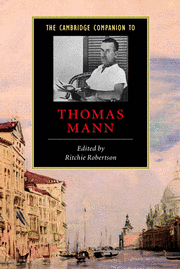Book contents
- Frontmatter
- 1 Mann and history
- 2 The intellectual world of Thomas Mann
- 3 Mann's literary techniques
- 4 Mann's man's world
- 5 Mann's early novellas
- 6 Classicism and its pitfalls
- 7 The political becomes personal
- 8 Buddenbrooks
- 9 The Magic Mountain
- 10 Religion and culture
- 11 Doctor Faustus
- 12 Lotte in Weimar
- 13 The Confessions of Felix Krull, Confidence Man
- 14 Mann as essayist
- 15 Mann as diarist
- 16 Mann in English
- Bibliography
- Index
3 - Mann's literary techniques
Published online by Cambridge University Press: 28 May 2006
- Frontmatter
- 1 Mann and history
- 2 The intellectual world of Thomas Mann
- 3 Mann's literary techniques
- 4 Mann's man's world
- 5 Mann's early novellas
- 6 Classicism and its pitfalls
- 7 The political becomes personal
- 8 Buddenbrooks
- 9 The Magic Mountain
- 10 Religion and culture
- 11 Doctor Faustus
- 12 Lotte in Weimar
- 13 The Confessions of Felix Krull, Confidence Man
- 14 Mann as essayist
- 15 Mann as diarist
- 16 Mann in English
- Bibliography
- Index
Summary
We no longer believe that truth remains truth once its veil has been removed.
Nietzsche (GS, preface, §4)In olden days a glimpse of stocking was looked on as something shocking, now, heaven knows, anything goes.
Cole PorterThomas Mann is chiefly known as a novelist in the European tradition. The novel is an artistic hybrid of storytelling, immoral behaviour and moral consciousness. This holds true for Thomas Mann's fiction, although in his case it is complicated by specifically German factors.
The first is that the German novel tradition has characteristics of its own. Both Goethe and the Romantics made distinct contributions to the literary genre of the novel, usually in the form of attempts to modify its hybrid constitution in one way or another. The Goethean Bildungsroman concentrates on the moral development of one individual character, and the artistic aspect of the novel’s composition is enhanced not only by this thematic focus, but also by the belief in the meaningful shape of the education process itself. As the protagonist is formed, so is the novel. The Romantics promoted the hybrid heterogeneity of the novel, its mixture of narrative and essayism, to the status of a defining principle of all art. For them it was (at least theoretically) the only art form equal to the task of capturing the metaphysical interpenetration of subjective and objective realities. Thomas Mann was conscious of both these strains in the German literary inheritance, and we shall return to them. But it is from Wagner’s music drama, which was understood by Mann and others to be the last flowering of Romanticism, that Mann most clearly derived aspects of his literary technique, aspects that strained against the novel form’s own pragmatic heterogeneity.
- Type
- Chapter
- Information
- The Cambridge Companion to Thomas Mann , pp. 43 - 63Publisher: Cambridge University PressPrint publication year: 2001



